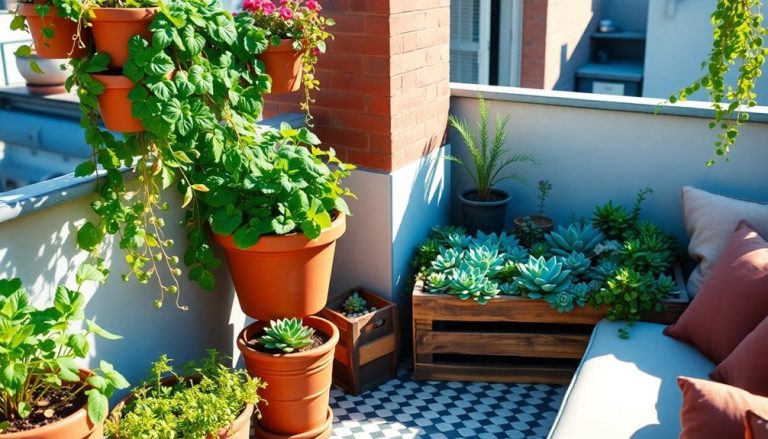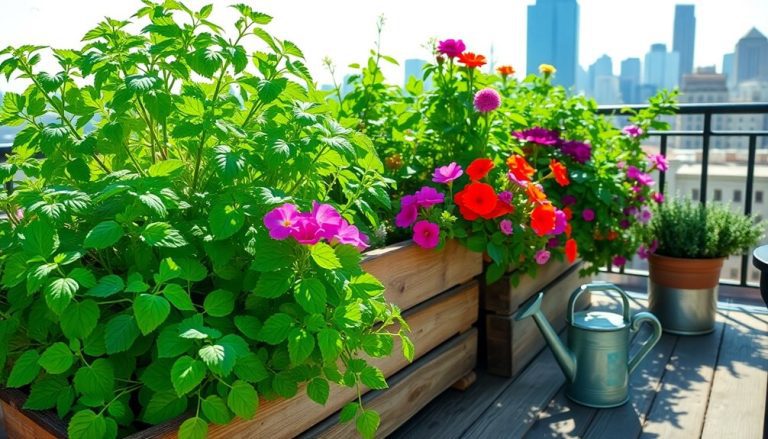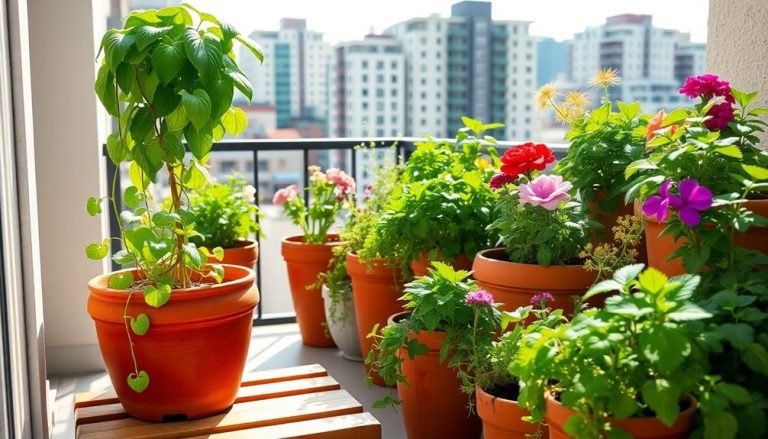If you want a stunning landscape that requires little upkeep, consider these five ideas. Start with drought-resistant plants like succulents and lavender, which thrive in dry conditions. Incorporate native plants to boost biodiversity and minimize care. Explore xeriscaping techniques to optimize water use and enhance soil moisture retention. Add low-maintenance hardscaping elements, such as gravel paths and paver patios, to reduce landscaping chores. Finally, set up automated irrigation systems for efficient watering tailored to your garden's needs. With these strategies, you can enjoy a beautiful outdoor space with minimal effort—keep going to discover more tips!
Key Takeaways
- Incorporate drought-resistant plants like succulents and lavender to minimize watering and maintenance needs.
- Utilize native plants to enhance biodiversity and reduce reliance on fertilizers and water.
- Implement xeriscaping techniques to improve soil moisture retention and optimize irrigation efficiency.
- Design with low-maintenance hardscaping materials like gravel paths and interlocking pavers for durability and minimal upkeep.
- Install automated irrigation systems for efficient watering schedules, conserving water while keeping your landscape lush.
Drought-Resistant Plants
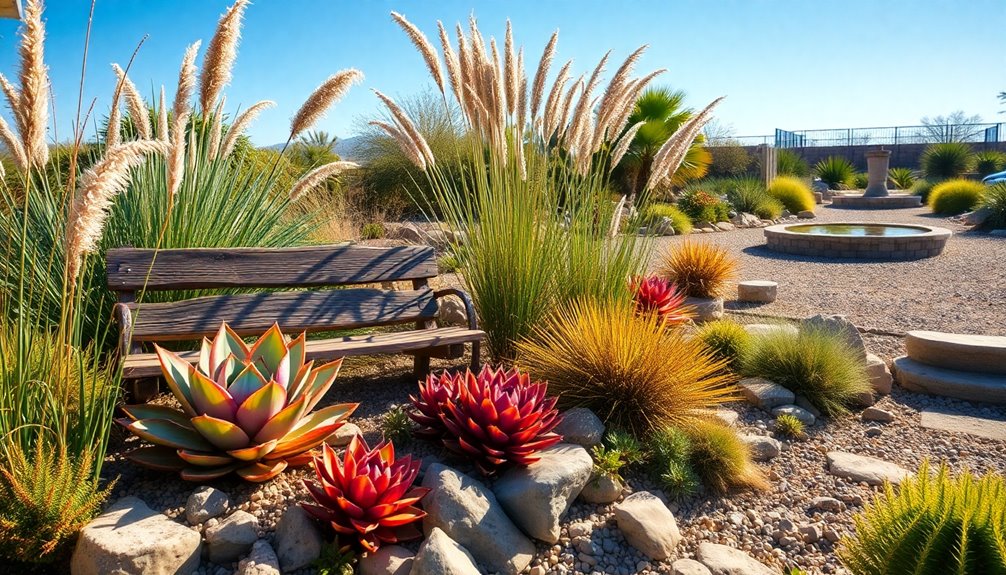
When you're designing a low-maintenance landscape, incorporating drought-resistant plants is a smart move. These plants thrive in dry conditions and require less water, making them ideal for busy homeowners or those in arid climates. You'll save time and resources by choosing species that naturally adapt to your environment. Consider including edible flower seeds in your landscape design, as they can offer both beauty and utility.
Start by selecting plants like succulents, lavender, or ornamental grasses. These choices not only survive on minimal water but also add unique textures and colors to your landscape.
Grouping plants with similar water needs can further reduce your maintenance efforts. Consider planting in clusters to create visual interest and reduce the area you need to water.
Mulching around these plants helps retain moisture and suppress weeds, making your job even easier. Incorporating stones or gravel in your design can enhance drainage and add an appealing aesthetic.
As you plan, pay attention to the sun and shade patterns in your yard, as some drought-resistant plants prefer full sunlight while others thrive in partial shade. Additionally, consider incorporating insect-repelling plants such as citronella to enhance your outdoor experience without the nuisance of pests. By making these thoughtful choices, you'll create a beautiful landscape that's easy to care for, allowing you to enjoy your outdoor space with minimal effort.
Native Plant Landscaping
Embrace the beauty of native plant landscaping to create a stunning and sustainable outdoor space. By choosing plants that naturally thrive in your region, you'll not only reduce maintenance but also enhance biodiversity. Native plants are adapted to local soil, climate, and pests, which means they require less water, fertilizer, and pesticides than non-native options. Additionally, many native plants have built-in resistance to local pests, reducing the need for organic pest control solutions.
When selecting native plants, consider incorporating a mix of trees, shrubs, and perennials that bloom at different times throughout the year. This variety will ensure your landscape remains vibrant and visually appealing across all seasons. Plus, native plants attract beneficial wildlife, like pollinators and birds, helping to create a lively ecosystem right in your backyard.
To design your landscape, group plants with similar water and sunlight needs together for efficient care. Lay down mulch to suppress weeds and retain moisture, further simplifying upkeep. Incorporating native grasses or ground covers can also reduce the need for mowing, saving you time and effort. Additionally, consider using a greenhouse for propagation to grow your native plants from seeds, ensuring a healthy start to your landscape.
Xeriscaping Techniques
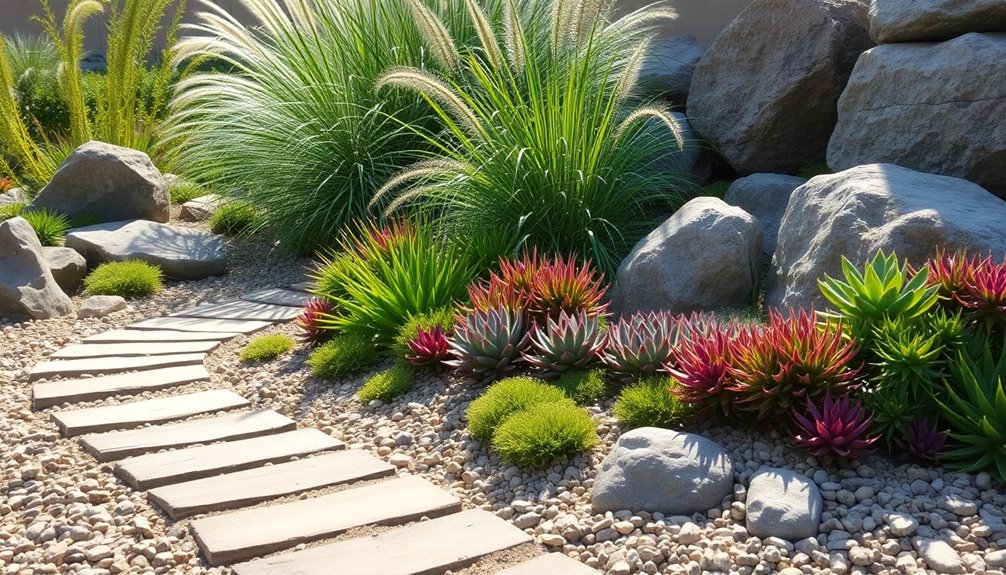
Xeriscaping techniques are a smart way to create a beautiful landscape while conserving water. By focusing on drought-resistant plants and efficient watering methods, you can enjoy a stunning yard with minimal upkeep. Start by selecting native plants that thrive in your climate, as they'll require less water and maintenance. Group plants with similar water needs together to optimize irrigation and reduce waste.
Here's a quick overview of effective xeriscaping techniques:
| Technique | Description |
|---|---|
| Soil Improvement | Amend soil with organic matter to enhance moisture retention. |
| Plant Selection | Choose drought-tolerant, native plants for lower water demand. |
| Efficient Irrigation | Use drip irrigation systems to deliver water directly to the roots. |
| Mulching | Apply organic mulch to reduce evaporation and suppress weeds. |
| Landscape Design | Create contours and berms to capture and retain rainwater. |
Incorporating drip irrigation systems can significantly improve water efficiency in your xeriscaped garden.
Low-Maintenance Hardscaping
Incorporating low-maintenance hardscaping into your landscape can complement xeriscaping techniques beautifully.
By choosing durable materials and thoughtful designs, you can create an outdoor space that requires minimal upkeep. Here are some ideas to consider:
- Gravel Paths: Use gravel or crushed stone for walkways, providing excellent drainage and a natural look.
- Paver Patios: Opt for interlocking pavers that withstand weather changes and don't need constant repair.
- Retaining Walls: Build with stone or concrete blocks to prevent soil erosion and enhance visual appeal without ongoing maintenance.
- Mulched Beds: Surround plants with mulch to suppress weeds and retain moisture, reducing your need for frequent weeding.
- Decorative Boulders: Integrate large stones as focal points, which require no care and add texture to your landscape.
These low-maintenance hardscaping options not only save you time and effort but also enhance the overall aesthetic of your garden.
Automated Irrigation Systems
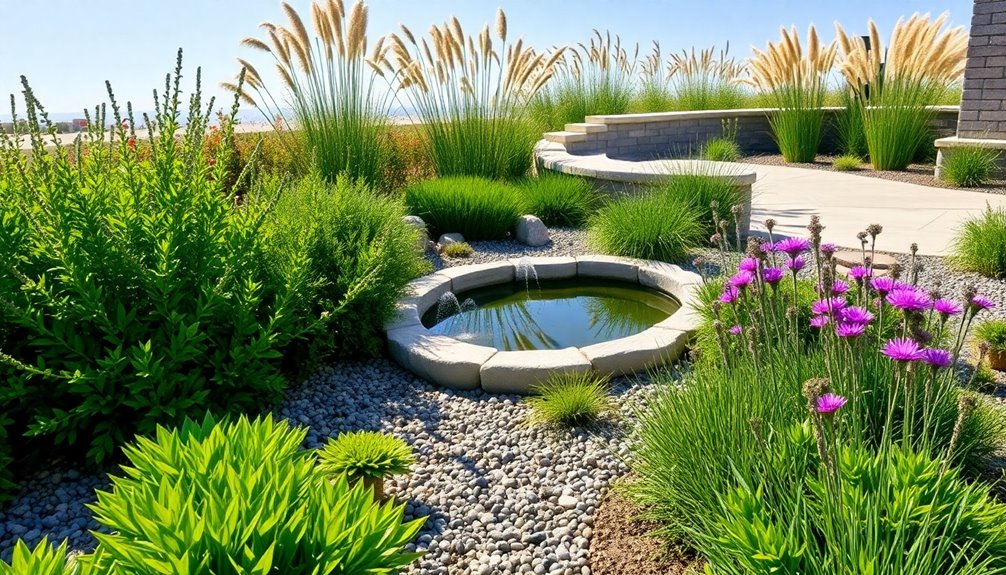
Automated irrigation systems can revolutionize your landscaping maintenance routine. By installing a system that waters your garden on a schedule, you'll save time and ensure your plants receive consistent hydration. No more guesswork or manual watering; these systems deliver the right amount of water exactly when your landscape needs it.
You can choose from various types, including drip irrigation, which targets plant roots directly, or sprinkler systems that cover larger areas. Smart controllers can adjust watering based on weather conditions, so you're not wasting water during rainy days. Some systems even connect to your smartphone, allowing you to monitor and adjust settings remotely.
Choosing the right system depends on your landscape's size, plant types, and your personal preferences. Once set up, you'll find that your garden thrives with minimal effort on your part. This means you can spend more time enjoying your outdoor space rather than laboring over it.
Incorporating an automated irrigation system not only enhances your landscape's health but also promotes water conservation. With these systems in place, you'll achieve a lush, vibrant garden without the hassle of daily maintenance. It's a smart investment for any low-maintenance landscape design.
Frequently Asked Questions
What Are the Costs Associated With Low Maintenance Landscaping?
When considering costs for low maintenance landscaping, you'll account for materials, installation, and potential ongoing upkeep. Choosing native plants and efficient irrigation systems can reduce these expenses, saving you money and time in the long run.
How Do I Choose the Right Plants for My Climate?
To choose the right plants for your climate, research your USDA zone, consider local rainfall and sunlight, and select native species. They'll thrive better and require less care, ensuring a healthier, sustainable landscape for you.
Can I Use Grass in a Low Maintenance Landscape?
Think of grass as a canvas; it can enhance your low maintenance landscape. You can use drought-resistant varieties for minimal upkeep. Just remember, choosing the right type is key to achieving a vibrant, effortless space.
What Tools Do I Need for Low Maintenance Gardening?
For low maintenance gardening, you'll need a few essential tools: a sturdy pair of pruners, a hoe for weeding, a trowel for planting, a rake for debris, and a watering can for efficient hydration.
How Often Should I Water Low Maintenance Plants?
When it comes to watering low maintenance plants, you'd wanna check the soil moisture first. Typically, once a week should do, but adjust based on rain and temperature. Don't overdo it; plants prefer a little dryness!
Conclusion
Incorporating low-maintenance landscape design ideas can transform your outdoor space into a beautiful, sustainable oasis. For instance, consider a homeowner in Arizona who replaced their traditional lawn with drought-resistant plants and xeriscaping techniques. Not only did they reduce water usage significantly, but they also created a vibrant, eco-friendly garden that thrives in the heat. By choosing the right plants and hardscaping, you can enjoy a stunning yard without the constant upkeep.


